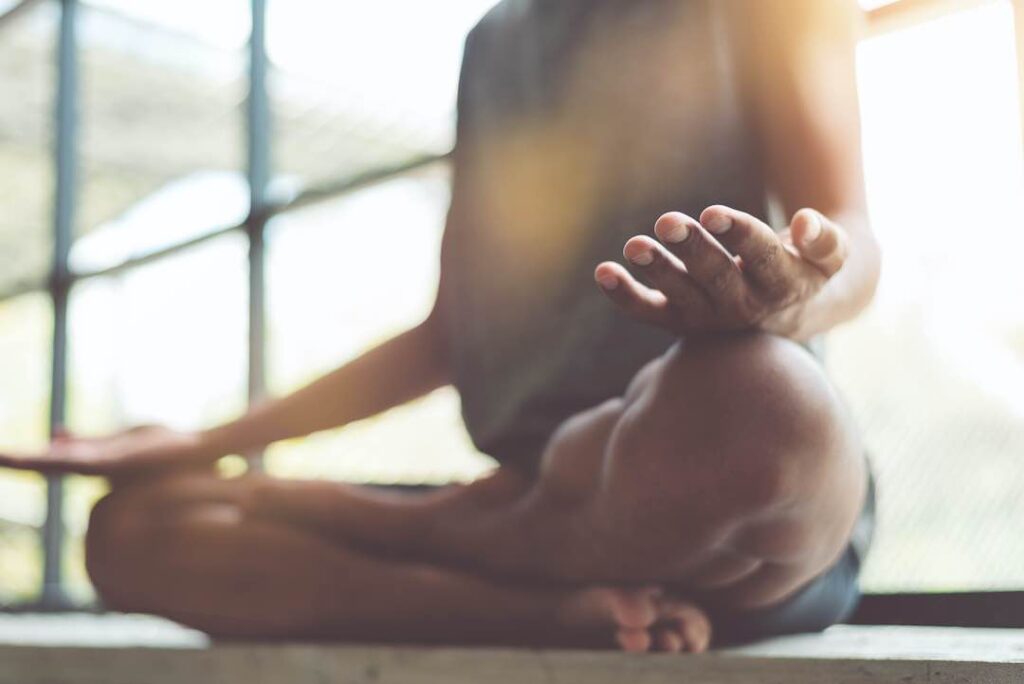When it comes to weight loss, we have to acknowledge the importance of the mind-body connection. Our stressful, hectic lives may literally be weighing us down. Research suggests mindfulness and breathing exercises can play a key role in reducing stress, managing cravings, and fostering a healthy relationship with food.
So, why is it possible that meditation and breathing exercises helps with weight loss, exactly? There are physical and psychological factors at play. A 2017 study found that meditation reduced cortisol and C-reactive protein levels. According to this study, when our cortisol levels are consistently high, this is connected with the persistence of obesity over time.
From a psychological perspective, research shows that meditation may help reduce overeating. A 2014 literature review found that using mindful meditation was the number 1intervention to decrease binge and emotional eating.
Meditation is often tossed out and disregarded because people question how sitting and not burning calories can help them lose weight. However, it is through meditation and mindfulness, that you are keeping the weight off as well as finding peace with food and your body. Best of all, you’ll find yourself becoming more confident, compassionate and loving towards the most important person in your life…you!
4 Breathing Exercises for Mindfulness & Meditation
1. Nose breathing
Breathe through your nose so you optimize your oxygen levels and avoid over-breathing, which can lead to increased food cravings. As if that is not enough, here are some key reasons why you should be nose breathing at all times:
- It imposes approximately 50% more resistance to the airstream than mouth breathing. This results in 10%–20% more oxygen uptake.
- Nasal breathing removes more germs and bacteria from the air you breathe.
- The nose is a reservoir for nitric oxide, an essential gas for the maintenance of good health. (Nitric oxide plays a central role in dilating the smooth muscle layer embedded in the airways to allow the greater transfer of oxygen to and from the lungs during exercise.)
- It will improve your sleep and energy levels.
- It will make it easier to breathe during exercise, thus allowing you to work out longer.
- It will improve the oxygenation of working muscles and organs to allow you to perform better.
Make a mindful effort throughout your day to keep your mouth closed and focus on breathing only through your nose. While sitting down, while standing up, while walking to work. Everywhere you go, start thinking about just keeping your mouth closed and taking small, calm breaths in through your nose and small, calm exhales out through your nose. Don’t over-breathe. Make sure everything is calm and relaxed.
2. Belly breathing
Breathe with your lower belly (engage your diaphragm) to relax the body, lessen cravings, improve digestion, and reduce emotional eating.
To practice belly breathing, you can either lay flat on the ground or sit or stand up tall with your spine neutral. Placing your hands just under the rib cage, inhale deeply through your nose, feel the air expand your belly and the rib cage as much as possible. While inhaling, be sure to keep your shoulders and chest down and relaxed. On the exhale, let the air out slowly through your nose while you actively drawing your belly up and in towards your spine by activating the abdominal muscles. Practice this breath for at least 10 minutes and enjoy the benefits of increased energy levels, a faster metabolism, and easier weight loss!
3. Rest & Digest Breathing
Activate your body’s rest-and-digest response by trying this belly breathing exercise at least 15 minutes before and after meals: Sit comfortably and relax your body Inhale by extending your lower belly outwardly for 5 counts Hold your breath for 4 counts Exhale by drawing the lower belly inwardly for 8 counts Hold your breath for 4 counts Repeat Steps 2-5 for at least 3 minutes each time.
4. Progressive Muscle Relaxation (PMR)
Progressive muscle relaxation is an exercise that relaxes your mind and body by progressively tensing and relaxation muscle groups throughout your entire body. You will tense each muscle group vigorously, but without straining, and then suddenly release the tension and feel the muscle relax. You will tense each muscle for about 5 seconds. If you have any pain or discomfort at any of the targeted muscle groups, feel free to omit that step. Throughout this exercise you may visualize the muscles tensing and a wave of relaxation flowing over them as you release that tension. It is important that you keep breathing throughout the exercise.
PMR How-To
Adapted from The Anxiety & Phobia Workbook, by Edmund J. Bourne
Begin by finding a comfortable position either sitting or lying down in a location where you will not be interrupted. Allow your attention to focus only on your body. If you begin to notice your mind wandering, bring it back to the muscle you are working on. Take a deep breath through your abdomen, hold for a few second, and exhale slowly. Again, as you breathe notice your stomach rising and your lungs filling with air. As you exhale, imagine the tension in your body being released and flowing out of your body. And again inhale…..and exhale. Feel your body already relaxing. As you go through each step, remember to keep breathing.
Now let’s begin.
Tighten the muscles in your forehead by raising your eyebrows as high as you can. Hold for about five seconds. And abruptly release feeling that tension fall away. Pause for about 10 seconds.
Now smile widely, feeling your mouth and cheeks tense. Hold for about 5 seconds, and release, appreciating the softness in your face. Pause for about 10 seconds.
Next, tighten your eye muscles by squinting your eyelids tightly shut. Hold for about 5 seconds, and release. Pause for about 10 seconds.
Gently pull your head back as if to look at the ceiling. Hold for about 5 seconds, and release, feeling the tension melting away. Pause for about 10 seconds.
Now feel the weight of your relaxed head and neck sink. Breath in…and out. In…and out. Let go of all the stress In…and out.
Now, tightly, but without straining, clench your fists and hold this position until I say stop. Hold for about 5 seconds, and release. Pause for about 10 seconds.
Now, flex your biceps. Feel that buildup of tension. You may even visualize that muscle tightening. Hold for about 5 seconds, and release, enjoying that feeling of limpness. Breath in…and out.
Now tighten your triceps by extending your arms out and locking your elbows. Hold for about 5 seconds, and release. Pause for about 10 seconds.
Now lift your shoulders up as if they could touch your ears. Hold for about 5 seconds, and quickly release, feeling their heaviness. Pause for about 10 seconds.
Tense your upper back by pulling your shoulders back trying to make your shoulder blades touch. Hold for about 5 seconds, and release. Pause for about 10 seconds.
Tighten your chest by taking a deep breath in, hold for about 5 seconds, and exhale, blowing out all the tension.
Now tighten the muscles in your stomach by sucking in. Hold for about 5 seconds, and release. Pause for about 10 seconds.
Gently arch your lower back. Hold for about 5 seconds, relax. Pause for about 10 seconds. Feel the limpness in your upper body letting go of the tension and stress, hold for about 5 seconds, and relax.
Tighten your buttocks. Hold for about 5 seconds…, release, imagine your hips falling loose. Pause for about 10 seconds.
Tighten your thighs by pressing your knees together, as if you were holding a penny between them. Hold for about 5 seconds…and release. Pause for about 10 seconds.
Now flex your feet, pulling your toes towards you and feeling the tension in your calves. Hold for about 5 seconds, and relax, feel the weight of your legs sinking down. Pause for about 10 seconds.
Curl your toes under tensing your feet. Hold for about 5 seconds, release. Pause for about 10 seconds.
Now imagine a wave of relaxation slowly spreading through your body beginning at your head and going all the way down to your feet. Feel the weight of your relaxed body. Breathe in…and out…in…out….in…out.

Dr. Kim Feinstein, Psy. D. is a Licensed Clinical Psychologist and Red Mountain’s Behavioral Weight Loss Specialist. She specializes in weight management, body image concerns, and eating disorders & prides herself in her ability to educate, guide, and inspire patients to overcome obstacles and ultimately achieve their goals.







